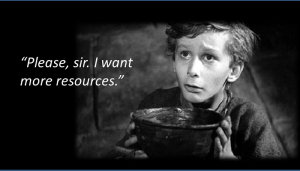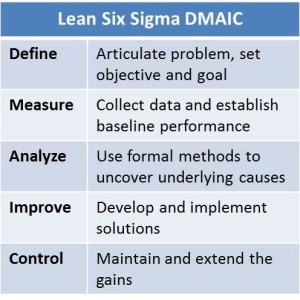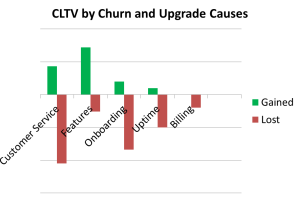 Executives are often barraged with heartfelt requests for additional staff, technology, training and other needs. Money is never abundant, so senior leaders must make tough decisions. When comparing competing requests, how can executives rationalize increased spending for Customer Success? Perhaps a time-honored quality improvement practice can help.
Executives are often barraged with heartfelt requests for additional staff, technology, training and other needs. Money is never abundant, so senior leaders must make tough decisions. When comparing competing requests, how can executives rationalize increased spending for Customer Success? Perhaps a time-honored quality improvement practice can help.
The measurement challenge
On the surface, justifying Customer Success investment seems straightforward. A benchmark and a “back of the envelope” calculation may be all that’s needed to build a business case. For example, according to a Pacific Crest survey, SaaS companies typically spend about 12% of sales on customer retention efforts.[1] All one needs to do is add the labor cost, technology and marketing expenditures incurred to retain or increase revenue and then divide by the total revenue. If it’s less than 12%, perhaps more spending is in order.
But looking a little deeper, Customer Success’ contributions can’t be taken in isolation. Customers typically defect because they experience shortcomings in value, quality or attachment to a particular vendor and can easily switch to someone else.[2] That means during the customer journey, multiple internal functions influence customer retention: Development, Marketing, Sales, Support, Professional Services, Customer Success and sometimes even Accounting. Customers evaluate their total experience when it comes to the decision to renew, so to attribute all retained revenue to just one department is dangerously misleading.
To build a more credible argument, one must narrow the analysis to the activities Customer Success teams uniquely perform. For example, leaders typically deploy CSMs to engage with customers and increase product adoption during the critical period immediately after the sale. Studies have shown a link between early usage and churn,[3] so the total cost of this process compared with the specific results can give a more accurate reflection.
And many have done just that. Faced with high churn, executives deployed new Customer Success teams and then measured their before-and-after revenue impact. If all other factors remained the same, managers could claim their new CSM investments caused the gain. Pointing to these results justifies further investment.
But for most firms, the analysis isn’t as clean. In the rush to solve the churn problem, few leaders take the time to properly establish metrics and record baseline conditions. When essential variables change over time (product features, customer segments, competition, process improvements) isolating Customer Success’ unique financial impact becomes an intractable problem. Once that egg is scrambled, it’s impossible to separate the white from the yolk.
Use DMAIC
 While the specific results from Customer Success spending may be hidden in most cases, one practical way to justify new investment is to estimate which changes, relative to others, will provide the greatest future economic benefit.
While the specific results from Customer Success spending may be hidden in most cases, one practical way to justify new investment is to estimate which changes, relative to others, will provide the greatest future economic benefit.
For years, manufacturing and service companies have used Lean Six Sigma process improvement methods to relentlessly increase quality, reduce time and cost. Lean Six Sigma’s DMAIC (which stands for phases of improvement: Define, Measure, Analyze, Improve and Control) can serve as a helpful framework for SaaS companies to increase their own performance. And good DMAIC practice estimates the financial impact of changes before making them.
- Define—Describe the objectives of the improvement project. Some organizations concentrate on churn reduction, some revenue expansion, others both. Scope the project globally to ensure multiple functions participate in the effort.
- Measure—Establish baseline performance. Collect historical data on the critical few metrics that indicate progress meeting goals. Track logo churn, revenue churn (positive or negative), upgrades or other financial KPIs.
- Analyze—Use tools such as “5 Why Analysis” to generate causal hypotheses and then collect and analyze data using statistical methods to verify your assumptions. For example, survey or interview current and former customers to learn why they defected and why they stayed. Compare root causes of problems as well as drivers for success. Order the factors by relative impact no matter where each originates—new product introduction, customer acquisition, service delivery or customer support. Estimate costs, risks, timelines and financial impact associated with for addressing the high impact areas.
- Improve—Develop and implement solutions. Pilot test on a limited scale, comparing actual performance to goals. Learn and refine as needed, then deploy to all areas.
- Control—Standardize, align metrics, recognition and rewards, control systems and training to hold the gains.
A properly designed and executed Analyze phase justifies investments for a range of potential actions using current business conditions as the guide. Executives can then compare, for example, how assigning an engineer to solve a long-standing reliability problem or adding another CSM to ensure more customers realize value can impact customer retention.
 After each DMAIC cycle, performance improves and spending tradeoffs change. Executives no longer need to make decisions based on who screams the loudest; they simply refer to the current process improvement project and invest in the areas linked to producing the best results.
After each DMAIC cycle, performance improves and spending tradeoffs change. Executives no longer need to make decisions based on who screams the loudest; they simply refer to the current process improvement project and invest in the areas linked to producing the best results.
When executives use DMAIC to tie their Customer Success spending directly to business impact in proper context with other options, decision making becomes much easier. And instituting the discipline drives ongoing revenue performance improvement, which is the end game.
Sources:
[1] Skok, D. (2014) 2014 Pacific Crest Saas Survey- Part 2; accessed 6/12/16
[2] Gremlera, D. and Brown, S. (1996) Service Loyalty: Its Nature, Importance, and Implications, University of Idaho and Arizona State University, USA
[3] Scout Research, The Data Behind Adoption and Retention in the Customer Journey; accessed 6/12/16
